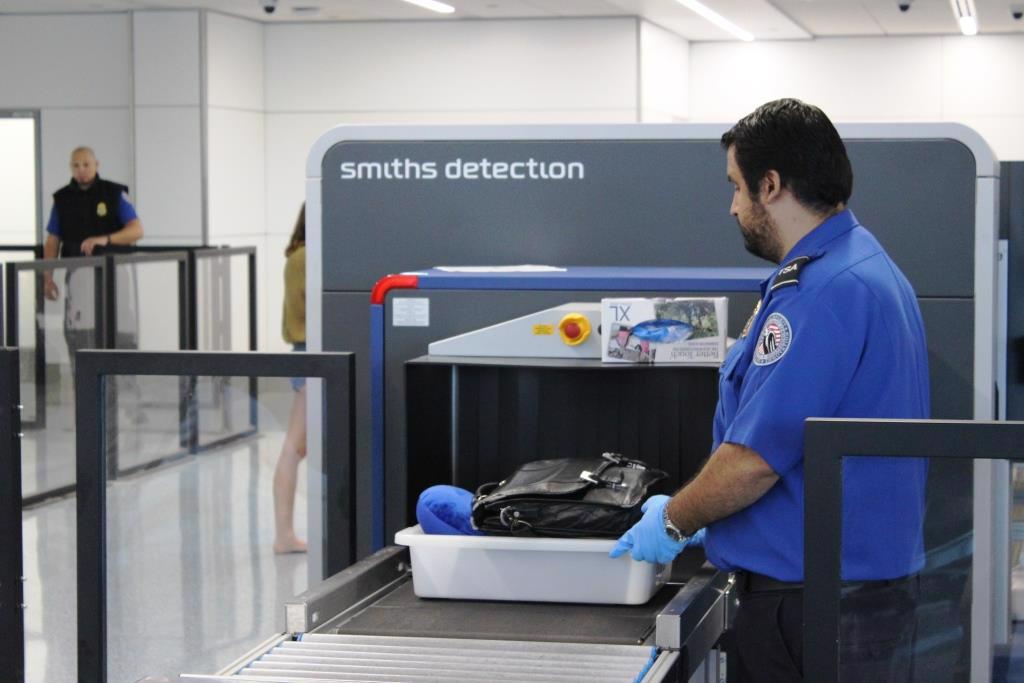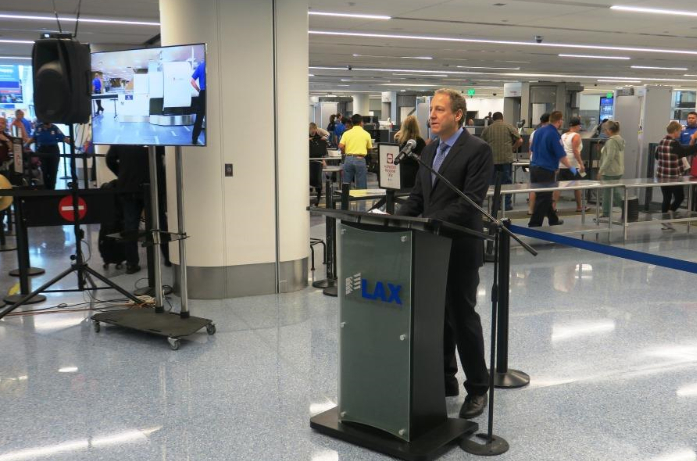For Immediate Release
August 30, 2018
Contacts:
Charles H. Pannunzio, LAWA Public Relations
(424) 646-5260 |
cpannunzio@lawa.org
Lorie Dankers, TSA Public Affairs
(206) 743-1497 |
lorie.dankers@tsa.dhs.gov

A TSA officer places a passenger's tray into the computed tomography (CT) scanner being tested in Terminal 1 at Los Angeles International Airport.
LAX AND TSA SHOWCASE NEW SCANNING AND SCREENING TECHNOLOGY AT TERMINAL 1
(Los Angeles, CA) Today, representatives from Los Angeles World Airports (LAWA) and the Transportation Security Administration (TSA) showcased emerging technologies currently in use at the security checkpoint in Terminal 1 at Los Angeles International Airport (LAX).
TSA is testing a computed tomography (CT) scanner to screen passengers’ carry-on luggage. The unit, which creates a 3-D image of the contents of the bag, is being tested in one lane at the checkpoint. The other technology in use is Credential Authentication Technology (CAT), which allows TSA to validate the security features of a passenger’s photo identification and match that information against the Secure Flight vetting system.
"The new technologies being tested at the Terminal 1 checkpoint are examples of how we can use emerging technologies to create a faster, easier and more secure experience," said Justin Erbacci, Chief Innovation and Commercial Strategy Officer, LAWA. "As we work to reimagine LAX, technology will be one of the ways we set ourselves apart from other airports. Our guests, as well as those at airports nationwide, will benefit from the testing of these processes and equipment."
 |
Justin Erbacci, Chief Innovation and Commercial Strategy Officer, LAWA, speaks to the media during Thursday's morning's news conference in Terminal 1.
CT units are the latest checkpoint X-ray scanning technology, designed to enhance threat detection capabilities for carry-on baggage as TSA continues to raise the baseline for aviation security. The technology is similar to CT technology used in the medical field.
TSA currently uses CT technology to screen checked baggage, but is just beginning to use it in the security checkpoint. The scanning technology is able to detect shapes and densities of items including bulk and liquid explosives that could be a threat to commercial aviation.
“Through research and development, TSA has determined that CT-based screening technology is the best option available today for screening carry-on bags,” said Keith Jeffries, TSA Federal Security Director at LAX. “We are pleased to partner with LAX so we can jointly learn more about how the system operates in a busy airport environment. In the future, our goal is to allow passengers to keep liquids inside their carry-on luggage during the checkpoint screening process.”
Keith Jeffries, TSA Federal Security Director at LAX, describes two new technologies being tested in Terminal 1 before media were able to see the systems in action.
TSA’s current screening technology for carry-on bags uses 2-D images. The CT technology applies sophisticated algorithms for the detection of explosives and other threats by creating a 3-D image that can be viewed and rotated 360 degrees for a thorough analysis by TSA officers. If a bag requires further screening, TSA officers will inspect it to ensure that a threat item is not contained inside.
TSA plans to have up to 40 units in place at airports around the nation by the end of the year, along with 16 units at federal testing facilities. TSA expects to have more than 145 units installed at airports by the end of fiscal year 2019.
TSA is testing several manufacturers of CT checkpoint technology, and the equipment at LAX is manufactured by Smiths Detection. For the most up-to-date information about CT and to view a video of the 3-D x-ray image, visit TSA’s
Emerging Technologies page at https://www.tsa.gov/computed-tomography.
TSA is also using Credential Authentication Technology (CAT) in Terminal 1. CAT units scan a passenger’s photo identification to verify the authenticity of the document. The system uses information from the photo identification to confirm a passenger’s flight status by cross-referencing against it against the Secure Flight database.
A TSA officer checks a passenger's identification using the Credential Authentication Technology (CAT) system that is being tested in Terminal 1 at LAX.
CAT enhances security by effectively verifying passenger identification to determine whether identification documents presented at the checkpoint are authentic, fraudulent or expired and verifying the passenger's Secure Flight vetting status in near real-time. When CAT is in use, the TSA officer will not request the passenger’s boarding pass unless the system is not able to access the individuals boarding information.
High-resolution photos of today's event are available by request. E-mail
cpannunzio@lawa.org for more information.
About Los Angeles International Airport (LAX)
LAX, the fifth busiest airport in the world and second in the United States, was named in Skytrax’ 2018 top 10 U.S. airports. LAX served more than 84.56 million passengers in 2017 and offers 737 daily nonstop flights to 100 cities in the U.S. and 1,386 weekly nonstop flights to 88 cities in 44 countries on 73 commercial air carriers. LAX ranks 14th in the world and fifth in the U.S. in air cargo tonnage processed, with more than 2.2 million tons of air cargo valued at over $101.4 billion. LAX handled 700,362 operations (landings and takeoffs) in 2017.
An economic study based on 2014 operations reported LAX generated 620,600 jobs in Southern California with labor income of $37.3 billion and economic output (business revenues) of more than $126.6 billion. This activity added $6.2 billion to local and state revenues and $8.7 billion in federal tax revenues. The study also reported that LAX’s ongoing capital-improvement program creates an additional 121,640 annual jobs with labor income of $7.6 billion and economic output of $20.3 billion, $966 million in state and local taxes, and $1.6 billion in federal tax revenues.
LAX is also the second most popular airport in the world to appear on Instagram according to wego.com. LAX is part of a system of two Southern California airports – along with Van Nuys general aviation – that are owned and operated by Los Angeles World Airports, a proprietary department of the City of Los Angeles that receives no funding from the City’s general fund.
For more information about LAX, please visit
www.flyLAX.com or follow on Twitter
@flyLAXAirport, on Facebook at
www.facebook.com/LAInternationalAirport, and on YouTube at
www.YouTube.com/laxairport1.
As a covered entity under Title II of the Americans with Disabilities Act, the City of Los Angeles does not discriminate on the basis of disability and, upon request, will provide reasonable accommodation to ensure equal access to its programs, services, and activities. Alternative formats in large print, braille, audio, and other forms (if possible) will be provided upon request.
About the Transportation Safety Administration (TSA)
The Transportation Security Administration was created to strengthen the security of the nation’s transportation systems and ensure the freedom of movement for people and commerce. TSA uses a risk-based strategy and works closely with the transportation, law enforcement and intelligence community to set the standard for excellence in transportation security. For more information about TSA, please visit our website at
tsa.gov.
# # #
